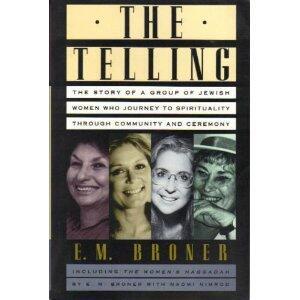E.M. Broner publishes "The Telling"
The Telling: The Story of a Group of Jewish Women Who Journey to Spirituality Through Community and Ceremony, by E.M. Broner, was released on March 1, 1993. The Telling is really two books in one: it includes both an account of the women’s seders, that, starting in 1976, Broner helped to organize in Manhattan, and also a copy of The Women’s Haggadah, the text that was created specifically for those seders.
The idea for The Women’s Haggadah was born in Israel in 1975, when Broner and Naomi Nimrod organized a seder that took women out of the kitchen and to the head of the table, and included women’s prayers and poems in their retelling of the Passover story. This prompted the two to write their own service for a feminist telling of the Passover story. The next year, in the spring of 1976, 13 women gathered in Broner’s New York City apartment for the first women’s seder. Among the attendees at this first seder were Gloria Steinem, Letty Cottin Pogrebin, and Phyllis Chesler. The Telling not only chronicles this first seder, but also the seder’s evolution through subsequent years, as the seder added guests, changed themes, and created new rituals.
The Women’s Haggadah, the text of these women’s seders, takes the traditional order of a Passover seder and views it through a feminist lens. The four questions have been altered to reflect Jewish women’s questions. The four sons have been changed to four daughters. The ten plagues have been transformed into the plagues that affect women today, such as false self-image, jealousy, and legal discrimination. Interspersed throughout the text are stories, songs, and poems about overlooked biblical Jewish women such as Miriam and Beruriah.
The Telling is only one in a long list of Broner’s works, all of which engage women’s experiences, and many of which explore combined Jewish and feminist themes. Her first book, Summer is a Foreign Land (1966), was quickly followed by the experimental Journal/Nocturnal (1968), Her Mothers (1975), and A Weave of Women (1978). More recently, Broner has written in an autobiographical strain, with Mornings and Mourning: A Kaddish Journal (1994) and Ghost Stories (1995), which describe her reactions to the deaths of her father and mother, respectively. Esther Broner, who began publishing under the name E.M. Broner when she felt that publishers were rejecting her work because of her gender, has also had success as a playwright and short-story writer. She received an O. Henry Prize, a National Endowment for the Arts Fellowship, and a Wonder Woman Foundation award “for courage in changing custom with ceremony.”
Esther M. Broner died in 2011.
Sources:Jewish Women in America: An Historical Encyclopedia, pp. 188-189; lts.brandeis.edu/research/archives-speccoll/findingguides/xml/broner.html; Ranen Omer, '"O, My Shehena, Who Shall Live In Your Tent?": Gender, Diaspora, and the Ambivalence of Return in E.M. Broner’s A Weave of Women,' Frontiers: A Journal of Women’s Studies 23:1 (2002).



